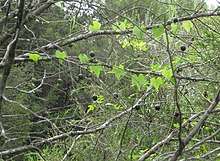Melothria pendula
Melothria pendula, also known as the creeping cucumber or the Guadeloupe cucumber, is a plant in the Cucurbiteae tribe. The plant is especially prominent in southeast regions of the United States. While a native plant, its fast-spreading nature makes it potentially weedy. The plant resembles the cultivated cucumber, possessing miniature yellow flowers, similar leaf shape, same leaf patterns, as well as similar growth patterns. The unripe berries strongly resemble minuscule watermelons.[1][2]
| Melothria pendula | |
|---|---|
.jpg) | |
| Scientific classification | |
| Kingdom: | Plantae |
| Clade: | Tracheophytes |
| Clade: | Angiosperms |
| Clade: | Eudicots |
| Clade: | Rosids |
| Order: | Cucurbitales |
| Family: | Cucurbitaceae |
| Genus: | Melothria |
| Species: | M. pendula |
| Binomial name | |
| Melothria pendula | |
.jpg)
Toxicity
The ripe berries, which are black, have powerful laxative qualities when consumed. The root, vines, leaves, and flowers have unknown toxicity.[3]
Edibility
The berries, when unripe and light green can be eaten raw. Dogs are known to eat the leaves without any apparent side effects.[4]
Ecology
The larvae of Hypercompe cunigunda have been recorded feeding on this plant.[5]
References
- "Creeping Cucumber". www.foragingtexas.com. Retrieved 2017-09-25.
- "US Wildflower - Creeping Cucumber, Guadeloupe Cucumber, Squirting Cucumber - Melothria pendula". uswildflowers.com. Retrieved 2017-09-25.
- "Melothria pendula". plants.ces.ncsu.edu. Retrieved 2017-09-25.
- "Creeping Cucumber". www.foragingtexas.com. Retrieved 2017-09-25.
- Gernaat, Hajo; Hielkema, Auke; Nijman, Elke; van Andel, Tinde (June 2016). "Host Plant and Late Larval Stages of Hypercompe cunigunda (Erebidae: Arctiinae) in Suriname". Journal of the Lepidopterists' Society. 70 (2): 163–166. doi:10.18473/lepi.70i2.a13. Retrieved 8 September 2018.
